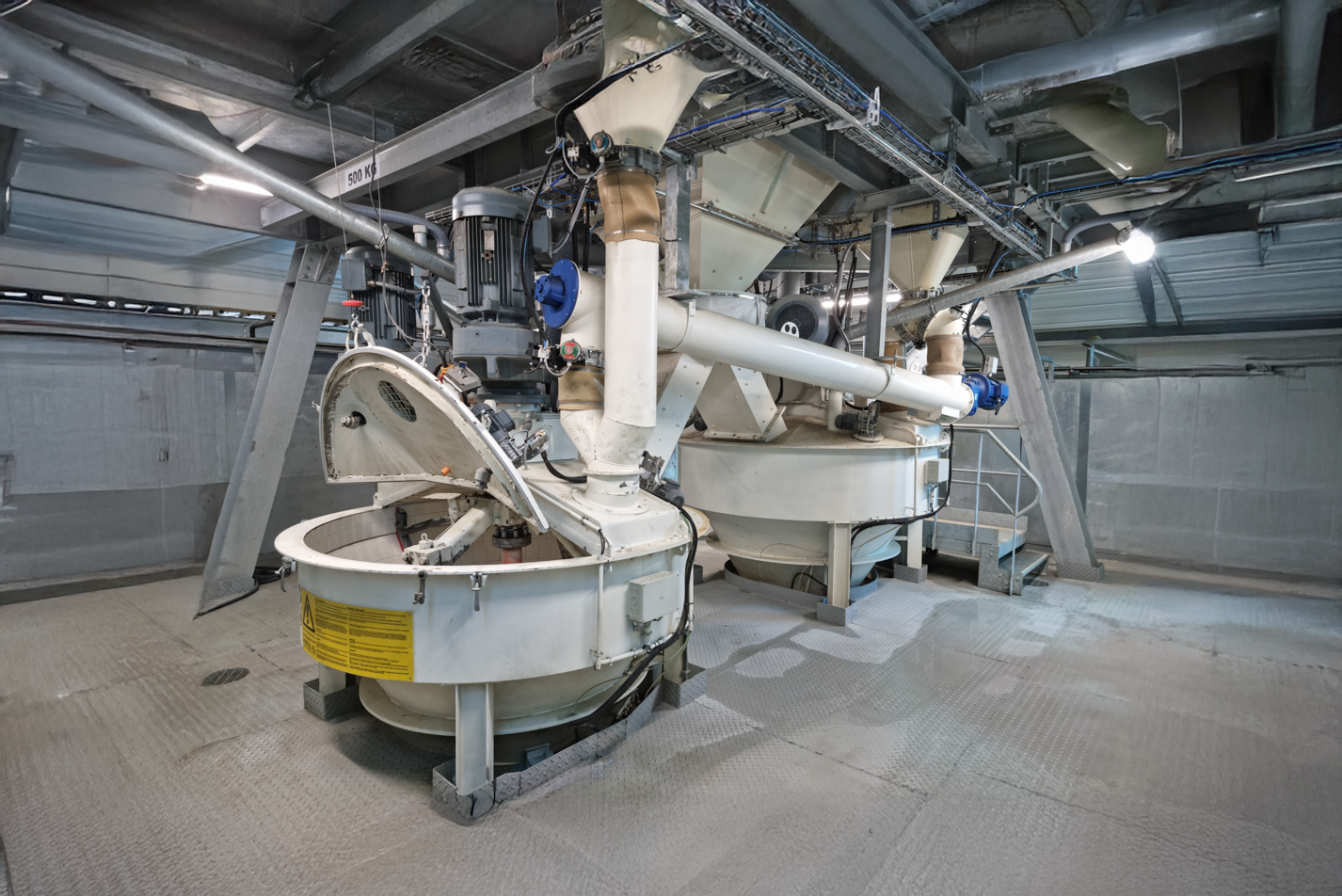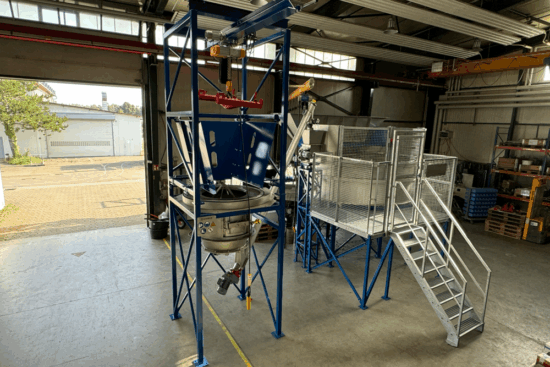Mixers — Comparative guide to help you choose (2025)
- 30 October 2025
- Posted by: Emelyne CHEVALIER--SEURE
- Categories: Concrete industry, Quarry & materials industry, Various industries
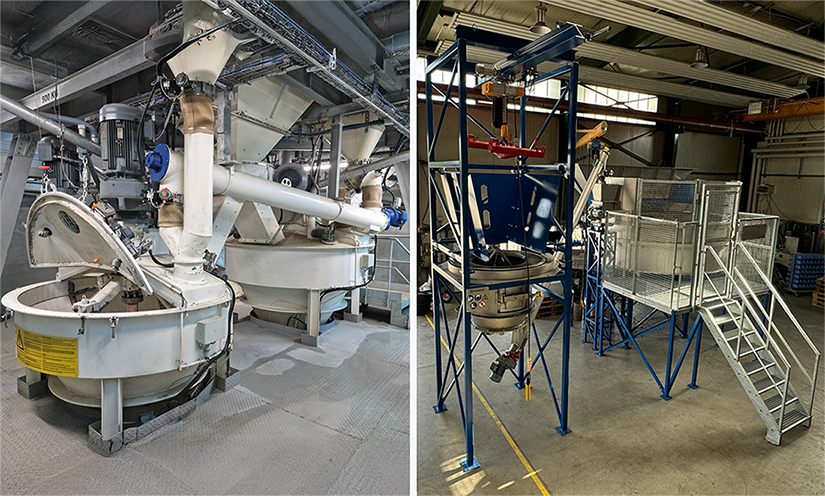
KKM conical mixer vs planetary mixer mixer planetary mixer
Kniele KKM conical mixer vs planetary mixer: in concrete, nuclear power, battery recycling, pharmaceuticals and agri-food, the choice of industrial mixer determines production rate, quality and total cost of production. This guide, intended for management and teams, compares these two technologies in terms of homogeneity, cycle times, energy consumption, maintenance and adaptability to materials (UHPFRC/UHPF, pigments, fibres).
Objective: to provide you with clear decision-making criteria and a selection grid to help you choose the most appropriate equipment for your performance, quality and compliance requirements.
Let us guide you step by step.
Mixing principle and technology: conical mixer vs planetary mixer
KKM conical mixer
The KKM is a conical mixer based on Archimedes’ principle (double counter-rotating agitation). On the one hand, a worm screw, equipped with propellers or blades arranged in a spiral, ensures the vertical transport and rotation of the product to be mixed. On the other hand, a mixing arm, combined with a scraper, rotates in the opposite direction while scraping the walls of the tank. This double mixing current generates a powerful vortex that ensures a homogeneous and rapid mixing of the components.
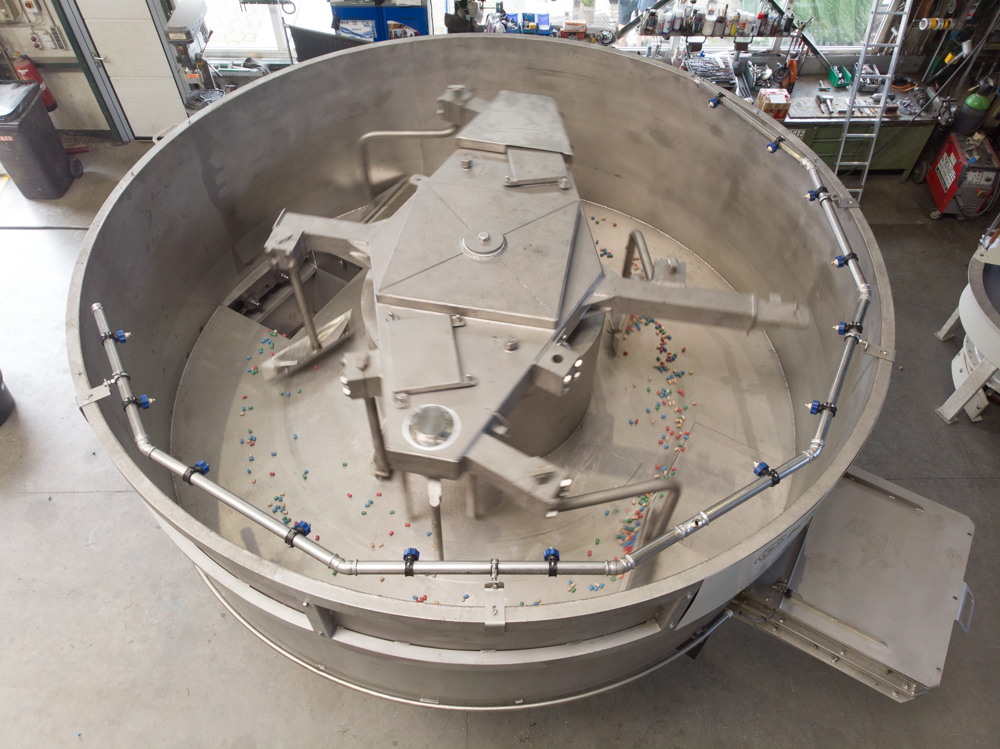
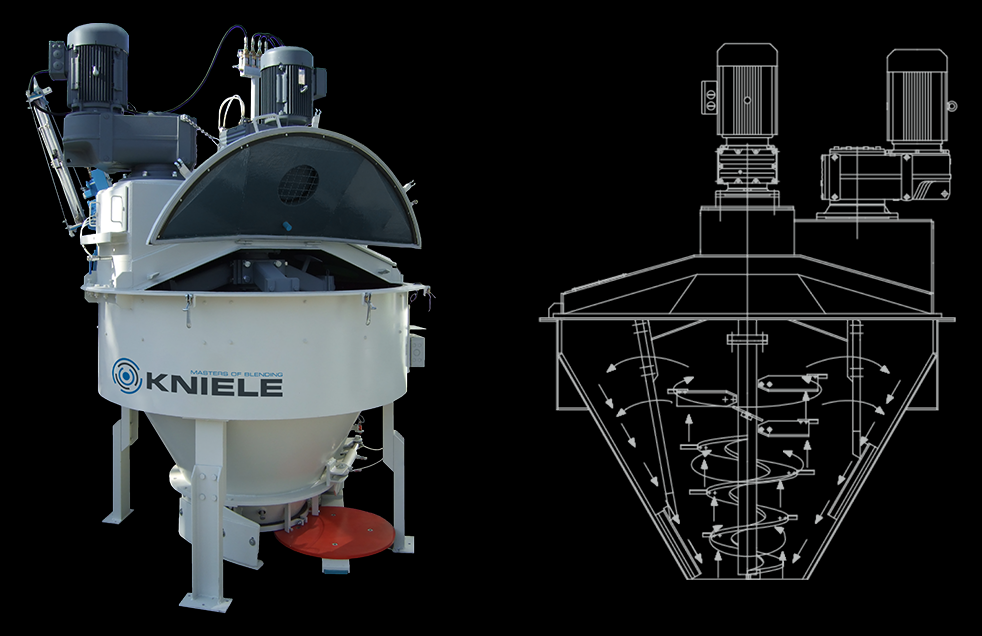
Planetary mixer
Planetary mixer sets in motion one or more arms equipped with blades that rotate on their axis while orbiting around the central axis of the tank, describing trajectories that intersect and overlap to sweep the entire volume while undergoing gravitational thrust; this kinematics generates shear and compression zones that promote the dispersion of aggregates, binders, additives and pigments, limits dead zones thanks to wall/bottom scrapers, and allows—via speed variator and adapted blade geometries—the mixing intensity to be adjusted according to the recipes.
Comparison criteria: advantages and disadvantages
To choose the right industrial mixer, first compare the mixing time and quality of the mixture, then the versatility (types of concrete, fibres, pigments, anhydrite). This section provides managers with concrete guidelines on KKM conical mixers vs planetary mixers.
Mixing time & mix quality
The conical KKM mixer offers rapid homogeneity thanks to counter-rotating dual agitation in a conical vessel, creating an Archimedes thrust effect; the mix is not subjected to gravitational pressure.
For a pre-mix, allow 4–6 minutes to wet and disperse properly.
For UHPC (BFUP/BFUHP), homogeneity is reached in 3–4 minutes.
A planetary mixer requires more than 20 minutes per cycle on recipes rich in fines.
The KKM maintains excellent quality even for small batches from 15% of useful volume.
The planetary remains homogeneous, but its more gradual kneading lengthens cycles, especially with very fine charges. Cement distribution within the aggregate skeleton is also less effective in the planetary mixer.
A planetary mixer does not make it possible to produce very small quantities relative to its useful volume while maintaining the same technical characteristics as at useful volume.
If throughput is strategic without sacrificing quality, the KKM creates a clear operational advantage by achieving 100% effective cement distribution and keeping technical characteristics identical from 15% of useful volume.
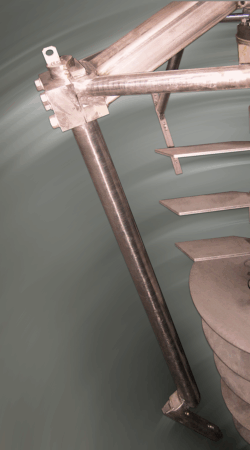
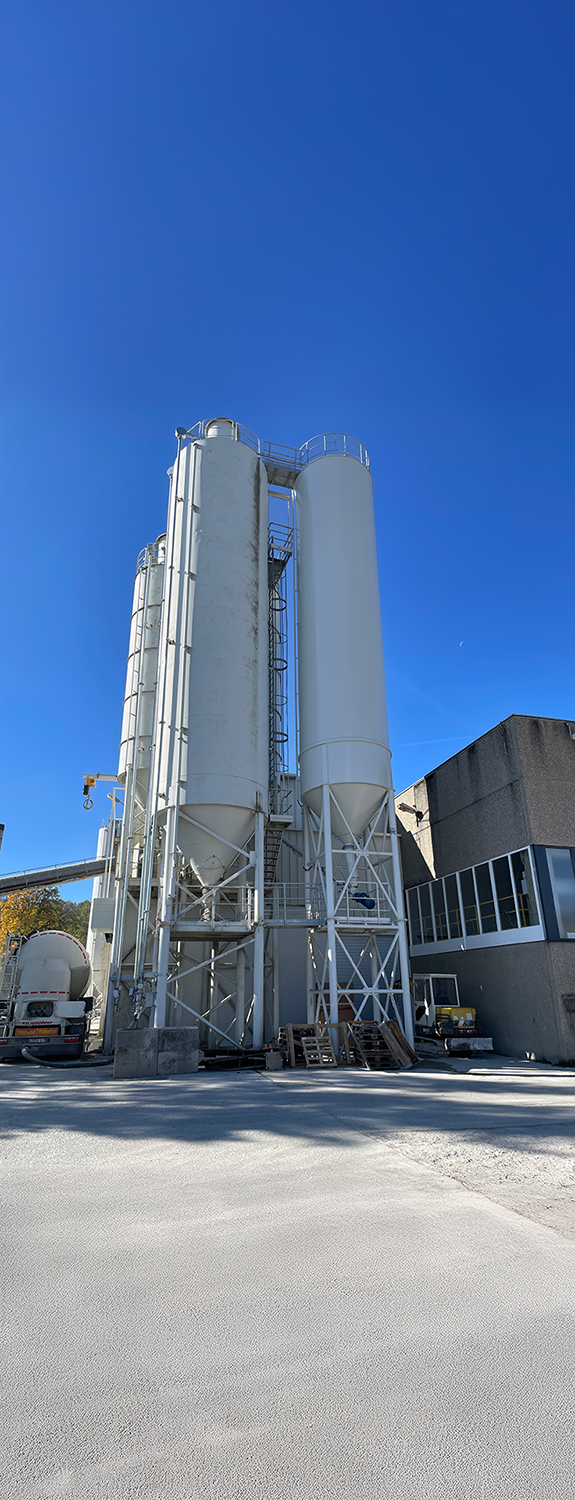
Versatility and types of mixtures
The conical KKM and the planetary mixer differ in versatility and in their ability to process various mixture types, meeting the demands of the concrete industry.
o Adaptation to different types of concrete
The KKM excels on UHPC/BFUHP, SCC/BAP, special mortars and traditional concrete.
Its kinematics accelerates fines dispersion and binder hydration on complex formulations.
It remains a reliable option for high-performance concretes, mortars and insulation materials (lightweight concretes based on perlite or vermiculite).
Planetary handles these families too, but with longer cycles on recipes highly loaded with fines, and may not always achieve perfect dispersion of fines.
o Ease of incorporating fibers, pigments and anhydrite
KKM facilitates the incorporation of fibers (metallic, synthetic, natural) without agglomerates; fibers can also be added into already-made concrete without issue.
Pigments are uniformly dispersed; color changes are fast and clean (reverse rotation, vertical flow).
Its sealed design allows water to be added first and thus performing grouts without leakage. The conical vessel and ease of cleaning permit separate handling of water with anhydrite, limiting cross-contamination.
A planetary mixer may require more time to eliminate fiber/pigment agglomerates, and does not provide fine control of mixtures when precision is paramount.
Cleaning and maintenance
Le malaxeur conique KKM se lave plus vite et coûte moins cher à maintenir que le malaxeur planétaire. Cette différence vient de la géométrie conique, de la trappe de vidange au point bas et du blindage céramique longue durée.
o Washing systems: manual vs automatic
Manual (KKM): full wash 10–15 min; intermediate rinse 3–5 min.
Automatic (KKM): with three high-pressure rotary heads and a telescopic lance, full wash 8–10 min, intermediate rinse 1–3 min. No residue remains at the bottom after manual or automatic wash.
Planetary: retains more residues because of the flat bottom. Manual: full wash 45–90 min, intermediate rinse 10–15 min (still leaves residue). Automatic: 45–60 min plus manual finishing to remove all residues.
o Time and annual maintenance cost
Per workstation, a KKM requires ≈140 h/year in manual washing; in automatic mode, ≈75 h/year. Automatic washing on a KKM reduces time by ~46% vs manual KKM, and by ~70% vs a planetary washed manually.
A planetary requires ≈253 h/year in manual and ≈220 h/year in automatic (excluding finishing), still far above a KKM.
o Wear, parts and downtime
The KKM simplifies upkeep thanks to the absence of a flat bottom and optimized scrapers. Its ceramic lining shows a 10–15-year service life depending on use.
A planetary requires more frequent replacement of scrapers and wear plates every 12–18 months, with longer downtime and recurring costs.
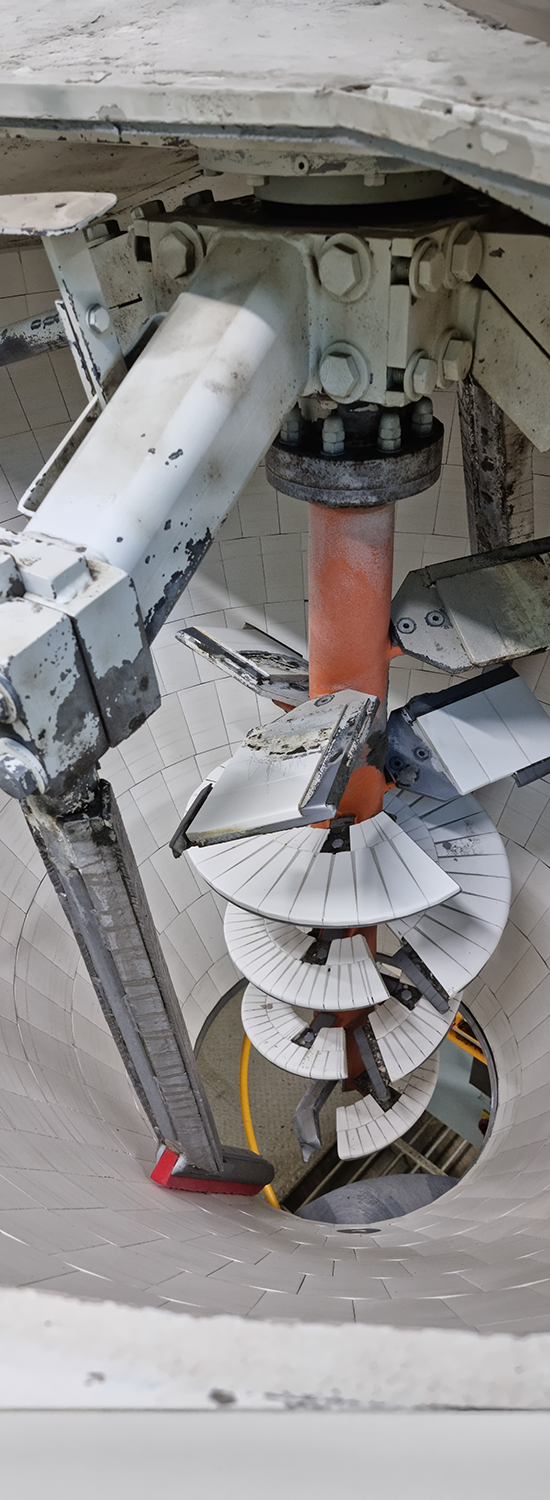
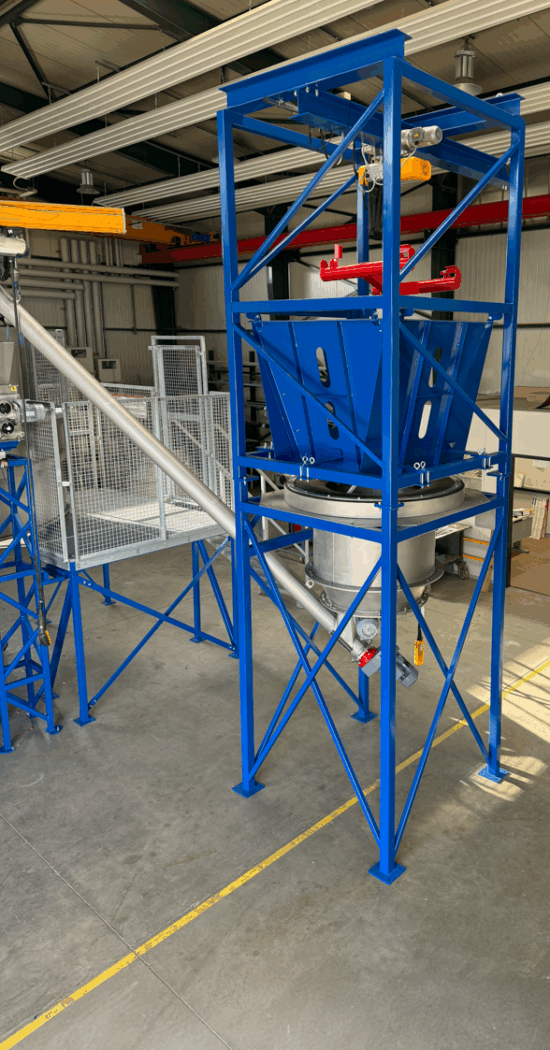
Discharge efficiency and waste reduction
Choosing a mixer directly impacts productivity, costs and environmental footprint.
The conical KKM discharges by gravity: up to 99% evacuated, without segregation and without residue in the vessel. A 2 m³ vessel empties in 3–4 s, subject to the receiving hopper’s capacity. The absence of a flat bottom limits residues, avoids segregation and maintains homogeneity to the last drop.
Fewer residues = less wash water, fewer effluents, less pollution and therefore lower costs.
Planetary requires mechanical pushing to the trap because the flat bottom favors aggregate segregation. Discharge 20–40 s, evacuates only 92–95%, leaving a remainder in the vessel. These residues generate more mineral waste, longer cleaning cycles and higher water consumption. Segregation at discharge can impair product quality, especially on fines-rich formulations.
For leadership aiming at throughput and durability, the KKM offers a safe bet via faster, more complete, cleaner discharge, with fewer losses and reduced environmental impact.
Conversely, the planetary entails slower, incomplete discharge and higher water and waste-treatment needs.
Water consumption and environmental impact
KKM reduces cleaning water by ~70% thanks to its optimized design and reduced residues.
An automatic 15-min wash uses ~250 L, with the possibility to reduce further in specific cases (e.g., nuclear grouting).
Likewise—due to mixing efficiency and the effect of Archimedes’ thrust—the water–cement ratio (w/c) is also reduced thanks to better distribution of the mixing water, unlike a planetary mixer.
This performance lowers potable water usage and treatment costs at recycling stations, across sectors (cement, concrete, pharmaceutical powders, special resins/polymers, eco-friendly insulation, flours and food additives, texturizing agents).
Conversely, a planetary requires more water to flush fines from the bottom: a 60-minute wash can reach ~3,300 L, leading to higher potable-water spend and a large volume of residues to treat.
In short, the KKM sharply reduces wash-related operating costs, lightens the load on effluent recycling, and improves the production ecological balance.
Wear and durability
Conical KKM has no flat bottom; a lateral vessel lining is required. The HARDOX discharge trap, acting as the bottom, is reversible to extend service life. With a ceramic lining, a KKM shows a service life >10 years, even with very abrasive aggregates. The ceramic lining is replaced every >10–15 years, sometimes never in certain plants, depending on abrasiveness and volumes produced. The reversible trap can be installed in <<30 minutes, limiting downtime.
Planetary requires regular replacement of bottom wear plates and vertical liners (internal/external) every 12–18 months. Replacing a 15 mm HARDOX liner implies high costs and ≥2 days of downtime, with a direct production impact. Over 10 years, this replacement can occur 5 to 8 times on a planetary. Likewise, replacing a discharge-trap liner generally takes 1 full day of production downtime.
Durability of the ceramic lining in the KKM and the quick replacement of the discharge trap significantly reduce maintenance costs and extend equipment life.
Footprint and installation
Conical shape of the KKM reduces floor footprint, while maintaining a height identical to standard models. The cone advantageously replaces the throw chute. Its physical design enables considerable space savings and easy maintenance.
For a planetary mixer, the platform area required is clearly larger than for a conical mixer. The large diameter makes thorough cleaning difficult without removing the guards.
Which mixer for which industry?
Conical KKM and the planetary mixer address different needs: the choice depends on recipes, target throughput and the company’s environmental constraints.
For productions requiring rapid homogeneity, efficient discharge and versatility (special concretes, UHPC, SCC, technical mortars, batches with fibers or pigments), the KKM is generally the most relevant: its counter-rotating kinematics and conical vessel promote very rapid dispersion, with configurations reaching up to 350 rpm and 2–3 minutes mixing time even for very specific concretes such as UHPC. R&D teams and innovation-oriented units value its repeatability, the ability to switch formulas, and the possibility to produce from 15% to 100% in the same mixer with minimal concrete residue thanks to the conical shape and bottom trap. Its discharge system limits non-conformities, facilitates color changes and reduces wash-water consumption—an asset for organizations committed to environmental initiatives. For sites prioritizing throughput and machine availability, the KKM’s short cycles + quick cleaning secure the sequencing of small and large batches and improve overall productivity.
Conversely, the planetary remains a valid alternative for standard precast and for contexts where a very fine control of mixing time is not required. In short, decision-makers will choose the KKM when the priority is fast homogenization, reduced losses and water sobriety, and will turn to the planetary for standard concretes without stringent requirements on quality and mixing time.
Which one to choose?
Chaque industrie possède des spécificités qui doivent répondre aux besoins de la production. Le choix entre le malaxeur conique KKM de Kniele et le malaxeur planétaire va porter sur les exigences de l’industrie.
Each industry has specificities that must meet production needs. The choice between the Kniele KKM conical mixer and the planetary mixer will hinge on industry requirements.
If speed, discharge efficiency and waste reduction are essential to your production challenge, the KKM conical mixer is the ideal solution for industries such as precast seeking cost optimization, high performance, great mix homogeneity and effective incorporation of admixtures. KKM’s undeniable advantage is its fast, complete discharge and simplified maintenance, while reducing losses and environmental impact.
Meanwhile, the planetary remains a relevant production tool for less complex, less demanding applications. It is appreciated in industries dedicated to standard precast concretes and in formulations that do not require precise control of mixing time.
